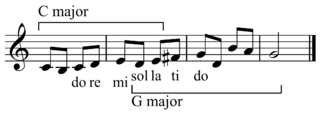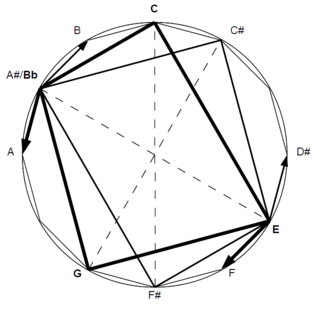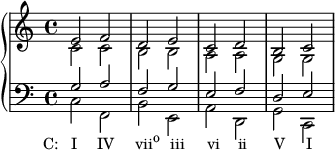An altered chord is a chord that replaces one or more notes from the diatonic scale with a neighboring pitch from the chromatic scale. By the broadest definition, any chord with a non-diatonic chord tone is an altered chord. The simplest example of altered chords is the use of borrowed chords, chords borrowed from the parallel key, and the most common is the use of secondary dominants. As Alfred Blatter explains, "An altered chord occurs when one of the standard, functional chords is given another quality by the modification of one or more components of the chord."
A jazz scale is any musical scale used in jazz. Many "jazz scales" are common scales drawn from Western European classical music, including the diatonic, whole-tone, octatonic, and the modes of the ascending melodic minor. All of these scales were commonly used by late nineteenth and early twentieth-century composers such as Rimsky-Korsakov, Debussy, Ravel and Stravinsky, often in ways that directly anticipate jazz practice. Some jazz scales, such as the bebop scales, add additional chromatic passing tones to the familiar diatonic scales.

A chord, in music, is any harmonic set of pitches consisting of multiple notes that are sounded simultaneously, or nearly so. For many practical and theoretical purposes, arpeggios and other types of broken chords may also be considered as chords in the right musical context.

In music, modulation is the change from one tonality to another. This may or may not be accompanied by a change in key signature. Modulations articulate or create the structure or form of many pieces, as well as add interest. Treatment of a chord as the tonic for less than a phrase is considered tonicization.
Modulation is the essential part of the art. Without it there is little music, for a piece derives its true beauty not from the large number of fixed modes which it embraces but rather from the subtle fabric of its modulation.

In music theory, the circle of fifths is a way of organizing the 12 chromatic pitches as a sequence of perfect fifths.. If C is chosen as a starting point, the sequence is: C, G, D, A, E, B, F♯, C♯, A♭, E♭, B♭, F. Continuing the pattern from F returns the sequence to its starting point of C. This order places the most closely related key signatures adjacent to one another. It is usually illustrated in the form of a circle.
A secondary chord is an analytical label for a specific harmonic device that is prevalent in the tonal idiom of Western music beginning in the common practice period: the use of diatonic functions for tonicization.
An augmented triad is a chord, made up of two major thirds. The term augmented triad arises from an augmented triad being considered a major chord whose top note (fifth) is raised. When using popular-music symbols, it is indicated by the symbol "+" or "aug". For example, the augmented triad built on A♭, written as A♭+, has pitches A♭-C-E:
In music, the submediant is the sixth degree of a diatonic scale. The submediant is named thus because it is halfway between the tonic and the subdominant or because its position below the tonic is symmetrical to that of the mediant above.
Chromaticism is a compositional technique interspersing the primary diatonic pitches and chords with other pitches of the chromatic scale. In simple terms, within each octave, diatonic music uses only seven different notes, rather than the twelve available on a standard piano keyboard. Music is chromatic when it uses more than just these seven notes.

In music theory, chord substitution is the technique of using a chord in place of another in a progression of chords, or a chord progression. Much of the European classical repertoire and the vast majority of blues, jazz and rock music songs are based on chord progressions. "A chord substitution occurs when a chord is replaced by another that is made to function like the original. Usually substituted chords possess two pitches in common with the triad that they are replacing."

In music, a guitar chord is a set of notes played on a guitar. A chord's notes are often played simultaneously, but they can be played sequentially in an arpeggio. The implementation of guitar chords depends on the guitar tuning. Most guitars used in popular music have six strings with the "standard" tuning of the Spanish classical guitar, namely E–A–D–G–B–E' ; in standard tuning, the intervals present among adjacent strings are perfect fourths except for the major third (G,B). Standard tuning requires four chord-shapes for the major triads.

The Andalusian cadence is a term adopted from flamenco music for a chord progression comprising four chords descending stepwise – a iv–III–II–I progression with respect to the Phrygian mode or i–VII–VI–V progression with respect to the Aeolian mode (minor). It is otherwise known as the minor descending tetrachord. Traceable back to the Renaissance, its effective sonorities made it one of the most popular progressions in classical music.
In music theory, the half-diminished seventh chord is a seventh chord composed of a root note, together with a minor third, a diminished fifth, and a minor seventh. For example, the half-diminished seventh chord built on B, commonly written as Bm7(♭5), or Bø7, has pitches B-D-F-A:

In jazz, a turnaround is a passage at the end of a section which leads to the next section. This next section is most often the repetition of the previous section or the entire piece or song.
The ii–V–I progression is a common cadential chord progression used in a wide variety of music genres, including jazz harmony. It is a succession of chords whose roots descend in fifths from the second degree (supertonic) to the fifth degree (dominant), and finally to the tonic. In a major key, the supertonic triad (ii) is minor, and in a minor key it is diminished. The dominant is, in its normal form, a major triad and commonly a dominant seventh chord. With the addition of chord alterations, substitutions, and extensions, limitless variations exist on this simple formula.

Diatonic and chromatic are terms in music theory that are most often used to characterize scales, and are also applied to musical instruments, intervals, chords, notes, musical styles, and kinds of harmony. They are very often used as a pair, especially when applied to contrasting features of the common practice music of the period 1600–1900.
In music, harmonization is the chordal accompaniment to a line or melody: "Using chords and melodies together, making harmony by stacking scale tones as triads".

In music, the vi–ii–V–I progression is a chord progression. A vi–ii–V–I progression in C major is shown below.
In music theory, Roman numeral analysis is a type of harmonic analysis in which chords are represented by Roman numerals, which encode the chord's degree and harmonic function within a given musical key.
The jazz minor scale or ascending melodic minor scale is a derivative of the melodic minor scale, except only the ascending form of the scale is used. As the name implies, it is primarily used in jazz, although it may be found in other types of music as well. It may be derived from the major scale with a minor third, making it a synthetic scale, and features a dominant seventh chord on the fifth degree (V) like the harmonic minor scale. It can also be derived from the diatonic Dorian mode with a major seventh.















